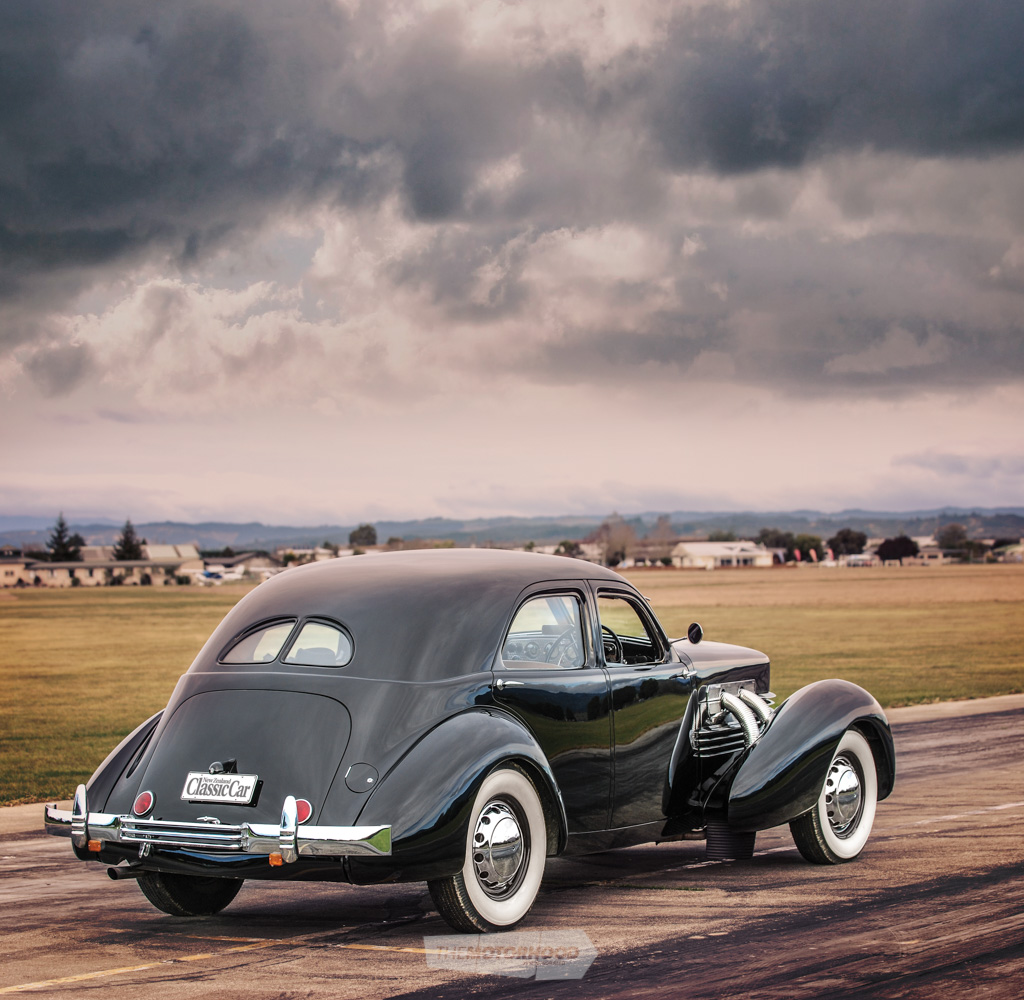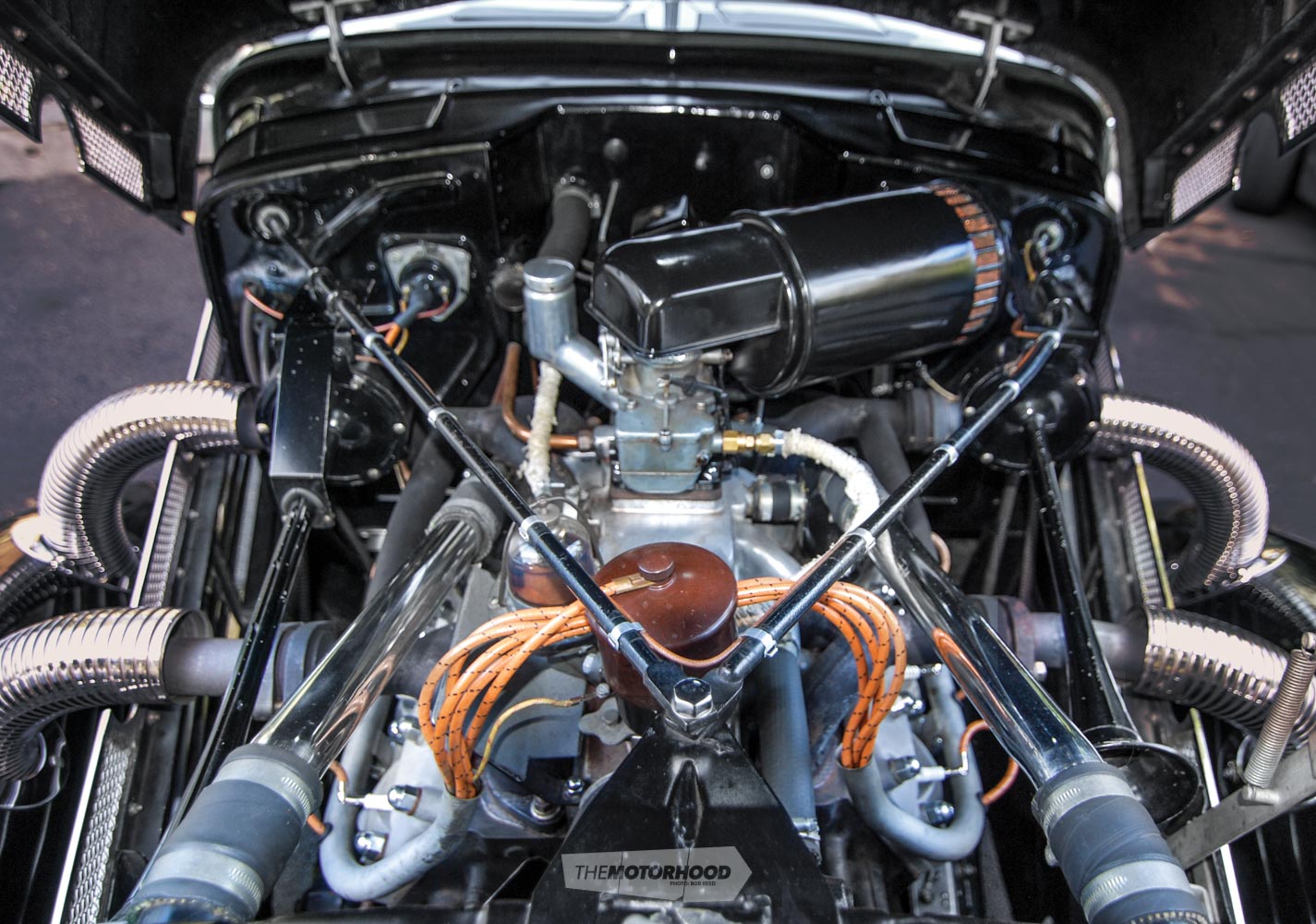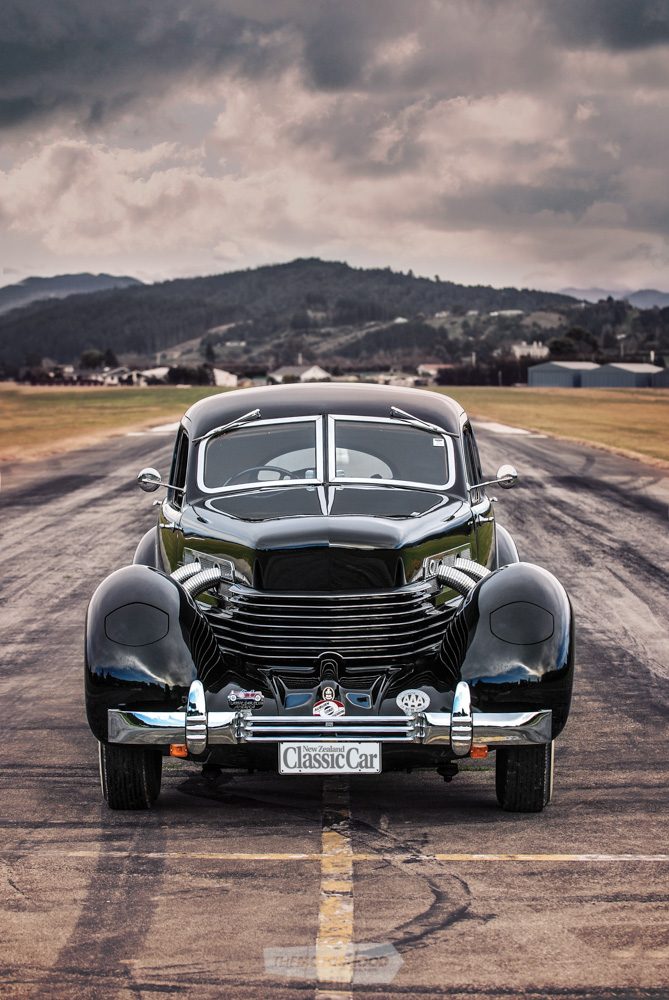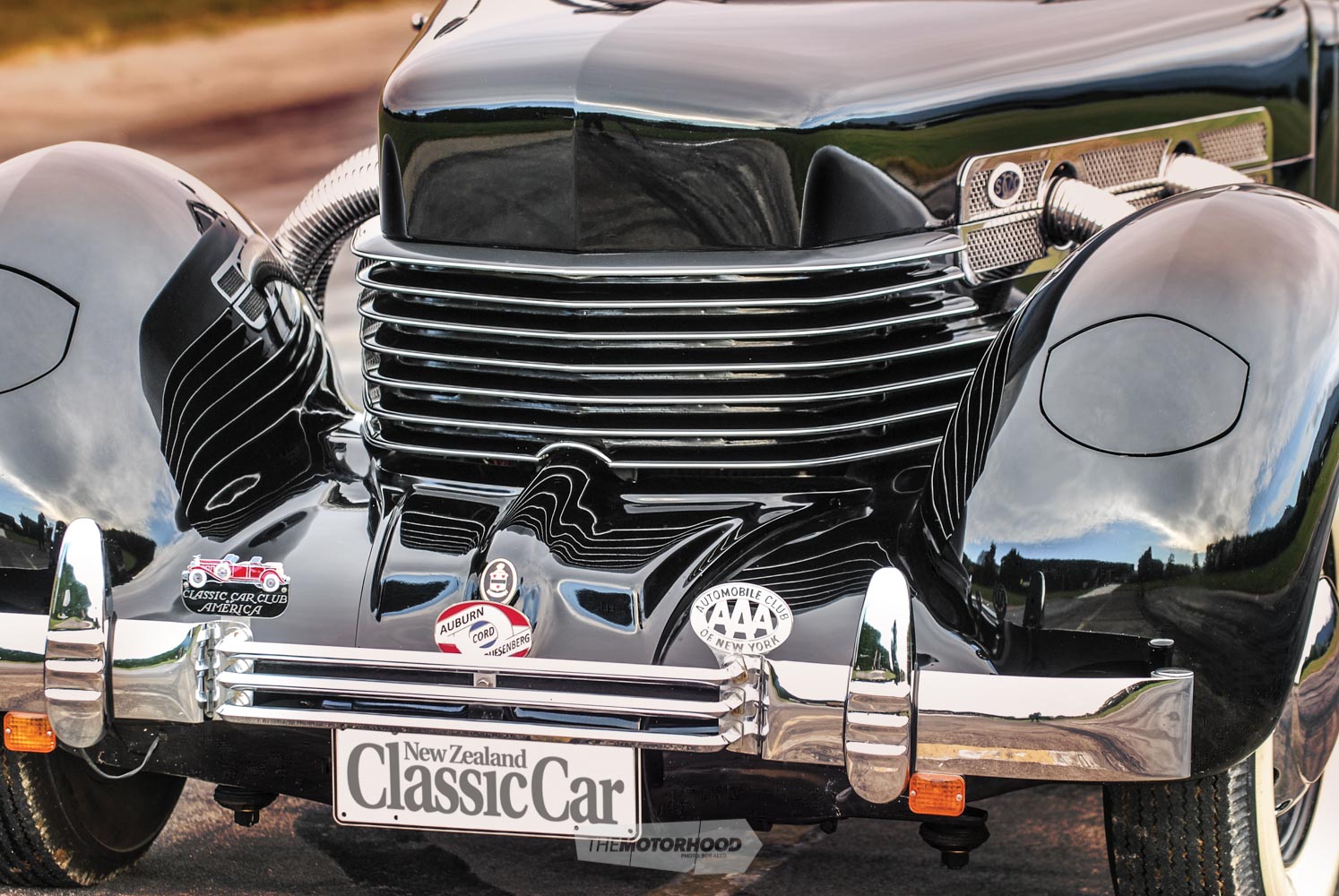“One of the great triumphs of American automotive design, simply nothing else could measure up to the Cord 810”

The Cord is considered by many enthusiasts to be one of the most aesthetically successful American-built cars of the mid 1930s. Its timeless proportions boasted sleek, distinctive, and unique design innovations, such as retractable headlights — individually raised and lowered by small crank handles located on the dash in front of the driver and passenger — the total elimination of running boards, a front-latched bonnet opening, ‘coffin-nose’ front-end styling, and teardrop-shaped front guards, all of which influenced other manufacturers’ designs in subsequent years. In addition to masterful design, the Cord incorporated radical engineering, including the use of front-wheel drive and an optional supercharged engine.
Unique opportunity
Cord’s story is brief but comprehensive nonetheless. Astute young businessman Errett Lobban Cord recognized an opportunity to build a truly unique car and bought the struggling Auburn Automobile Company (AAC) in 1925. Earlier that year, Harry Miller had wowed the automotive world by taking second place in the Indianapolis 500 behind the wheel of his Junior 8 Special — the first front-wheel-drive car to compete in the famous race. Within a year, and after taking over another great American racing name of the day — Duesenberg — things were looking good for Errett Cord and his burgeoning empire. The portfolio of his Cord Corporation included glitzy Auburn cars, Lycoming engines, Stinson aircraft, and Checker taxicabs among its offerings, but Cord was without a namesake marque.
Undoubtedly keen to rectify the situation, Cord employed the services of Miller to assist in the development of America’s first front-wheel-drive production car. In June 1929, the stylish Cord L-29 was the first front-wheel-drive car sold in America. It offered dramatically different styling and mechanical complexity, proving the true genius of Errett Cord and the engineering prowess of Harry Miller. It was the first vehicle from Mr Cord’s namesake brand.
Radically different to any other car on the market, the Lycoming straight-eight–powered Cord, modified to drive a front-mounted transaxle assembly, offered extremely low-slung styling that allowed designer Alan H Leamy to create a beautifully stylish car.
Initial sales were fairly buoyant, but, in the end, timing played a cruel hand when the stock market crashed in late October 1929. About 5000 L-29s were sold before production ended on December 31, 1931 — that number wasn’t considered meagre by any means, especially for an expensive car launched on the eve of the Great Depression, but sales volume was insufficient to justify keeping the L-29 in production.

Next chapter
While AAC was grappling with issues surrounding the L-29, the next chapter in Cord’s history book was in the planning at General Motors (GM). Gordon Buehrig had been the chief body designer for Duesenberg since 1929. By 1933, declining sales of the prestigious marque had caused him to move on to GM. The company launched an internal design competition, and Buehrig submitted an outlandish streamlined sedan featuring a blunt nose, externally mounted radiators, and concealed headlights, which ultimately got the thumbs down from styling head Harley Earl, GM’s design king. However, all was not lost, as Buehrig’s fellow competing designers put it in first place ahead of all the other designs.
Soon after, Duesenberg president Harold Ames was able to entice Buehrig back to the company to have him develop a lower-priced companion for the Duesenberg J, and a baby Duesenberg project was launched in late 1933. Its shape was based on drawings that had been soundly rejected months earlier by his then-boss Harley Earl. In a strategic move, AAC management sidelined the project to focus the company’s attention on the more mainstream Auburn brand — creating 1935’s stunning 851 boat-tail speedster. When focus was eventually diverted back to creating a new small luxury model, Buehrig’s design team and the company engineers were under the pump and had to quickly ready the car for its crucial November 1935 auto-show debuts. Buehrig’s revolutionary design became the Cord 810 of 1936, overshadowing everything else on the show floors with its breathtaking lines — it was considered one of the truly outstanding cars of the era.
Cord’s cars
Cord started by modifying Model Ts, but the cars that he produced later were technologically advanced, stylish, and among the best performers of their day — arguably some of the most significant American designs ever.
Top left: Duesenberg Model J 1928–’38, Top right: Auburn Cabin Speedster 1928–’29
Lower left: Cord L-29 1929–’32, Lower right: Auburn 851 and 852 Speedsters 1935–’36
Long and low, the front-wheel-drive Cord 810 received a conventional radiator but retained Buehrig’s concealed headlights and blunt coffin-nose front end with wraparound horizontal bars. Under the bonnet was a Lycoming V8 engine mated to a four-speed gearbox actuated by a Bendix Electric Hand shifter.
The interior design features of the 810 were just as enterprising as its exterior, with a beautifully functional aircraft-inspired instrument panel boasting an engine-turned aluminium fascia and fancy edge-lit instrumentation, which used a luminous dye applied to the edges of the glass of the dials to light them.

Lack of funds
As beautiful and innovative as the cars were, the company lacked the necessary capital to properly develop them and bring them to market — the goal of producing 1000 per month never eventuated. The 1937 model, renamed the ‘812’ but virtually identical to the 810, added two long-wheelbase sedans and an optional supercharger with chrome-plated side exhausts snaking out of the hood.
While the design would prove timeless, sadly, time had run out for Cord. About 3000 of the 810/812 series were made before production came to a halt in August 1937, by which time Cord had cashed out his ownership of the company and retired to California. By end of the year, the company was in bankruptcy, and the innovative Cord became an intriguing footnote in automotive history. However, the design and engineering would inspire for decades, and, to this day, these wonderful cars enjoy an enthusiastic following of both owners and admirers.

Many owners fitted the external pipes not just for their aesthetic appeal but because they helped to cool the engine, acting as large vents for the heat to escape
Surprising discovery
Graham Gibson, owner of this fabulous 1936 Cord 810 Westchester, has had a fascination with cars for as long as he can remember. Growing up across the ditch in Sydney, Graham’s preference was for British cars, especially MGs, and he confesses to have almost owned the full book, including a TC, TD, TF, and an MGA prior to marrying his wife, Aleksandra, back in the ’60s. From that point, Graham progressed into a more family-friendly cars such as a MkIII Zephyr before a succession of company cars in the ensuing years.
Graham also built up an engineering business during that time, and it wasn’t until the mid 1980s, when the business had settled down, that he decided to search for a restoration project. In 1987, while visiting a friend, Graham happened to glance up into the rafters of the large shed and notice a pair of front mudguards that belonged to a Cord. Graham knew straight away what he was looking at because of the distinctive retractable headlights. Unable to resist asking more questions about the car, Graham learned that it belonged to a friend of his friend, who had discovered the car in a barn in Victoria. Sadly, the Cord had been completely pulled apart and left for many years, which had encouraged unscrupulous vandals to wreak havoc on the car. Subsequently, the Cord was purchased and taken back to Sydney to be restored. Apparently, it was in so many pieces that no two pieces were bolted together, and, not long after commencing the restoration, the owner and his wife divorced. The owner was then forced to downsize and ended up living in a much smaller home unit, which meant that there was no room for the Cord, and the parts were farmed out to various friends all over Sydney to store, Graham’s friend being one of them.
As Graham was gazing up at these very unique front guards, his friend told him that if the owner would be interested in selling the car, he’d see if he could collect all the parts together for Graham. Graham’s friend was able to do just that, providing the opportunity for Graham and Aleksandra to purchase it in 1987.

New project
Graham managed to relocate all the parts of the Cord into his workshop and began to carry out further research to find out exactly what he’d bought. After looking at a few pictures of completed cars, liking what he saw, he discovered that his particular model was only manufactured in 1936 and ’37, and that ‘Westchester’ was the name of an upmarket suburb in New York. He also discovered many more of the Cord’s unique features that he had been unaware of, such as its Lycoming V8 front-wheel-drive system, which was produced only for the Cord.
After a few months of scratching his head, wondering where to begin, Graham started working, based on the philosophy that the more parts he bolted together, the fewer there would be to worry about. However, this easier said than done, as the car was in so many pieces, with no record or indication as to where anything belonged. Graham reckoned that there wasn’t a nut on a bolt anywhere. What made the project even more of a challenge was the fact that the engine and complicated pre-select gearbox had also been completely stripped apart, and the vandals had taken to every panel, piece of glass, and instrument with what appeared to be a large hammer, leaving Graham with the Herculean task of resurrecting this rare car back to its former glory.

Night classes
The Cord was the first American unitary body–constructed car, and, luckily for Graham, there was not much rust in the body except for a few small patches along the bottoms of the doors. He delegated the task of fabricating new parts to his engineering apprentices, while he addressed the chrome.
Now, this was back in the days when six-month technical night courses were available, and Graham took full advantage of this by enrolling in a chrome-plating course. For the price of $100 and one night per week, he could chrome plate all that he could carry — not a bad deal when you consider the price of chrome plating, even back then.
Once the body was completed, it was painted in its original colour — black. Graham completely reconditioned the matching-numbers engine and gearbox to original specifications. He discovered that the V8 engine has an extremely unusual firing order, which runs completely down one side before firing on the other, and the car used the original six-volt system. The suspension and brakes were also completely restored to original specifications. The supercharger pipes are not standard on this model — they were only available in 1937 — however, as the earlier cars suffered from overheating issues due to the concealment of the upper portion of the radiator, so many owners fitted the external pipes not just for their aesthetic appeal but because they helped to cool the engine, acting as large vents for the heat to escape.

The Buehrig-designed Cord 810 was launched at the Chicago Auto Show. Extraordinarily advanced for it day, it became the only car to be honoured by the New York Museum of Modern Art as one of its finest examples of industrial styling of all time
The original maroon leather interior, which Graham felt looked rather dark, was changed to a much lighter tan that complements the black exterior very nicely. He was able to purchase new dial faces for the smashed-up gauges and had the entire instrument cluster refurbished to its original state.
From start to finish, the complete restoration took Graham about seven years, although he admits to running hot and cold with the project during that time.
When he and Aleksandra moved to New Zealand — relocating to Nelson — in 2005, they brought the Cord with them, along with their 1927 Cadillac Sport Phaeton, an original unrestored survivor.
When asked if he gets much opportunity to drive the Cord much Graham replied, “Yeah, I drive it down to get the milk and bread sometimes, and we take it on the odd rally.”

1936 Cord 810 Westchester
ENGINE: 90-degree V8
CAPACITY: 4736cc (289ci)
BORE/STROKE: 89x95mm
VALVES: Side-valve, two valves per cylinder
COMP. RATIO: 6.5:1
MAX POWER: 93kW
FUEL SYSTEM: Stromberg carburettor, mechanical pump
TRANSMISSION: Four-speed pre-select manual
BODY/CHASSIS: Unitary steel body with subframe
SUSPENSION F/R: Independent front with trailing arm / Solid rear on semi-elliptical leaf springs
STEERING: Ball-bearing gear
BRAKES F/R: Drum/Drum
Dimensions
WHEELBASE: 3352mm
TRACK F/R: 1422mm/1549mm
OVERALL LENGTH: 5143mm
WIDTH: 1803mm
HEIGHT: 1524mm
WEIGHT: 1860kg
TOP SPEED: 150kph
PRODUCTION: Approx. 3000












